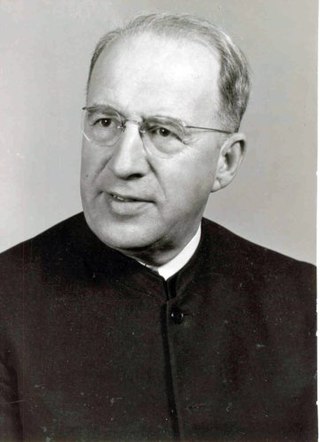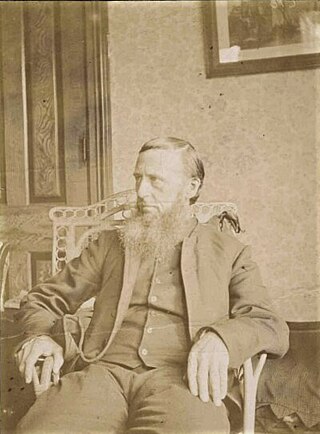The Mennonite Historical Library (MHL) is considered the world's most prominent and complete collection of resources and artifacts pertaining to Mennonites and related Anabaptist groups. It is housed in the Harold and Wilma Good Library on the campus of Goshen College in Goshen, Indiana. The specialty library was founded in 1906 under the guidance of Harold S. Bender and Ernst Correll. Elizabeth Miller is the current director.

Harold Stauffer Bender was a prominent professor of theology at Goshen College and Goshen Biblical Seminary. His accomplishments include founding both the Mennonite Historical Library and The Mennonite Quarterly Review. He served as president of the American Society of Church History, and was a major scholarly influence on fellow Mennonite theologian John Howard Yoder.

The General Conference Mennonite Church (GCMC) was a mainline association of Mennonite congregations based in North America from 1860 to 2002. The conference was formed in 1860 when congregations in Iowa invited North American Mennonites to join together in order to pursue common goals such as higher education and mission work. The conference was especially attractive to recent Mennonite and Amish immigrants to North America and expanded considerably when thousands of Russian Mennonites arrived in North America starting in the 1870s. Conference offices were located in Winnipeg, Manitoba and North Newton, Kansas. The conference supported a seminary and several colleges. In the 1990s the conference had 64,431 members in 410 congregations in Canada, the United States and South America. After decades of cooperation with the Mennonite Church, the two groups reorganized into Mennonite Church Canada in 2000 and Mennonite Church USA in 2002.

Julia Mae Spicher Kasdorf is an American poet.

John Fretz Funk was a publisher and leader of the Mennonite Church. Funk published the Herald of Truth from 1864 until 1908 when it merged with the Gospel Witness to form the Gospel Herald. Jacob Clemens Kolb, in his preface to Bless the Lord, O My Soul quotes an unnamed commentator who said, "John F. Funk is the most important [Mennonite] man after Menno Simons."

The Global Anabaptist Mennonite Encyclopedia Online (GAMEO) is an online encyclopedia of topics relating to Mennonites and Anabaptism. The mission of the project is to provide free, reliable, English-language information on Anabaptist-related topics.

Mennonites in Paraguay are either Plautdietsch-speakers of mostly Flemish, Frisian and Prussian ancestry or, like the majority of Paraguayans, of mixed or Amerindian ancestry. Ethnic Mennonites contribute heavily to the agricultural and dairy output of Paraguay.
The Mennonite Church USA Archives was founded in 2001 under the denominational merger of the (old) Mennonite Church and the General Conference Mennonite Church. Prior to 2001, the two largest Mennonite denominations maintained separate archives: the Archives of the Mennonite Church, located on the Goshen College campus, housed materials pertaining to the (old) Mennonite Church, while the Mennonite Library and Archives on the Bethel College campus held the records of the General Conference Mennonite Church.
Emma Elizabeth Richards was the first Mennonite woman to be ordained as a pastor of a Mennonite congregation.
John S. Coffman was a leader in the Mennonite Church in the late 19th century. He promoted evangelical and progressive reform through his positions in the Mennonite Publishing Company, revival meetings and chairmanship of the Elkhart Institute.
John C. Wenger was an American Mennonite theologian and professor.
Marten Schagen was a Dutch Mennonite bookseller, translator, journal editor and historian.
C. Henry Smith was a Mennonite historian born in Metamora, Illinois. Smith was the first (known) American Mennonite to earn a Ph.D., doing so at the University of Chicago in 1907. C. Henry Smith taught two stints at Goshen College and became the first dean of the college, before going on to teach at Bluffton University for the rest of his life. Smith's doctoral dissertation was published as The Mennonites of America in 1909 and remained the only comprehensive Mennonite history of American Mennonites into the 1950s.

Lois Gunden was the fourth of five Americans to be recognized as Righteous Among the Nations by Yad Vashem, the Shoah Martyrs' and Heroes' Remembrance Authority of Israel. She helped establish an orphanage and rescue mission for children in Southern France during World War II. She rescued some children directly from Camp de Rivesaltes, an internment camp.
Ira David Landis was a Mennonite minister, amateur historian, and writer famous for his contributions to the Mennonite Research Journal and for founding the Lancaster Mennonite Historical Society and Hans Herr House museum. He also ran a farm with his wife in Lititz, PA. Landis was president of the Pennsylvania German Society for 1972.
John Stanley Oyer (1925-1998) was an Anabaptist scholar and editor.

John Horsch was a Mennonite historian and writer.
Horsch is a German surname. Notable people with the surname include:
Mennonite literature emerged in the mid-to-late 20th century as both a literary movement and a distinct genre. Mennonite literature refers to literary works created by or about Mennonites.








